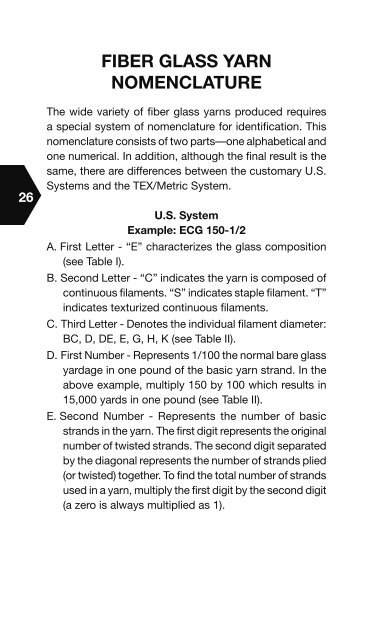View the 2009 Technical Fabrics Handbook - Graco Supply
View the 2009 Technical Fabrics Handbook - Graco Supply
View the 2009 Technical Fabrics Handbook - Graco Supply
Create successful ePaper yourself
Turn your PDF publications into a flip-book with our unique Google optimized e-Paper software.
26<br />
FIBER GLASS YARN<br />
NOMENCLATURE<br />
The wide variety of fiber glass yarns produced requires<br />
a special system of nomenclature for identification. This<br />
nomenclature consists of two parts—one alphabetical and<br />
one numerical. In addition, although <strong>the</strong> final result is <strong>the</strong><br />
same, <strong>the</strong>re are differences between <strong>the</strong> customary U.S.<br />
Systems and <strong>the</strong> TEX/Metric System.<br />
U.S. System<br />
Example: ECG 150-1/2<br />
A. First Letter - “E” characterizes <strong>the</strong> glass composition<br />
(see Table I).<br />
B. Second Letter - “C” indicates <strong>the</strong> yarn is composed of<br />
continuous filaments. “S” indicates staple filament. “T”<br />
indicates texturized continuous filaments.<br />
C. Third Letter - Denotes <strong>the</strong> individual filament diameter:<br />
BC, D, DE, E, G, H, K (see Table II).<br />
D. First Number - Represents 1/100 <strong>the</strong> normal bare glass<br />
yardage in one pound of <strong>the</strong> basic yarn strand. In <strong>the</strong><br />
above example, multiply 150 by 100 which results in<br />
15,000 yards in one pound (see Table II).<br />
E. Second Number - Represents <strong>the</strong> number of basic<br />
strands in <strong>the</strong> yarn. The first digit represents <strong>the</strong> original<br />
number of twisted strands. The second digit separated<br />
by <strong>the</strong> diagonal represents <strong>the</strong> number of strands plied<br />
(or twisted) toge<strong>the</strong>r. To find <strong>the</strong> total number of strands<br />
used in a yarn, multiply <strong>the</strong> first digit by <strong>the</strong> second digit<br />
(a zero is always multiplied as 1).


